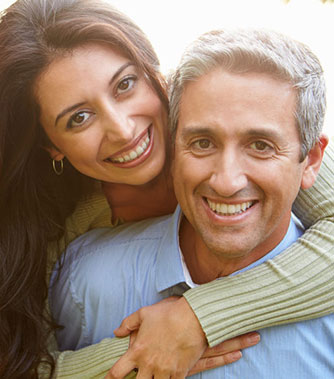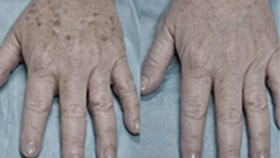Photodynamic Therapy
Benefit from a Two-Part, Light-Activated Medication in Marco Island and Naples, FL
Photodynamic therapy (PDT) at the Naples, FL-based Skin Wellness Physicians is what is known as a two-stage treatment, designed to address a range of skin issues. The first stage involves the application of a special medication, called a photosensitizer. The second stage involves activating the medication by exposing it to light, prompting a planned reaction that kills off targeted cells or bacteria.
While the light is often blue—earning this strategy the nickname of “blue light treatment”—the truth is that many different light sources may be used for a session, which has both medical dermatology and cosmetic applications.
Contact Skin Wellness Physicians to discuss photodynamic therapy in Naples, FL, and Marco Island, including photodynamic therapy cost, before-and-after images, results, and more. Arrange a consultation by sending a message online or calling (239) 732-0044.
JUST THE FACTS
- Photodynamic therapy has two parts: application of a topical medication and activation with light
- Different wavelengths of light are used for different purposes, depending on a patient's needs
- This therapy can treat everything from persistent acne to pre-cancerous lesions to skin cancer
How Does Photodynamic Therapy Work?
Photodynamic therapy at SWFL involves the use of the topical medication Levulan®, which contains an organic compound known as aminolevulinic acid. Levulan® is dispensed to physicians in a stick form—the Kerastick®— for ease of application to the skin of patients being treated for “pre- cancerous" rough patches called actinic keratoses.
On the photodynamic therapy treatment day, your provider will first wipe the skin dry or de-grease it with alcohol, then use Kerastick® to apply the Levulan® directly to the surface.
A CLOSER LOOK AT PHOTODYNAMIC THERAPY: FREQUENTLY ASKED QUESTIONS
What is aminolevulinic acid? Aminolevulinic acid is what is known as the precursor of a metabolite made naturally in the body: protoporphyrin IX.
What is a metabolite? A metabolite is a substance that results from metabolism, which is a naturally occurring process that breaks down other things, whether food, medications, or naturally occurring tissue.
What is protoporphyrin IX? Protoporphyrin IX is an organic compound that the skin produces on its own in very low levels. Certain diseases prompt creation of this metabolite at higher levels, which ultimately results in the development of skin rashes when exposed to the sun. As a result of these sunlight-based skin reactions, the exposed areas very rarely develop skin cancers.
Once the photodynamic therapy medication has been applied, the patient must wait in the office—or may be permitted to leave for a short time before returning. The clinical staff will guide the patient to the right place to get specific light exposure. The duration of the waiting time depends on what the photodynamic therapy treatment is targeting, whether actinic keratoses, skin cancer, problematic acne, or other issues. The light source itself—whether blue light, red light, or intense-pulsed light—also depends on the treatment specifics.
Once the proper amount of incubation time has passed, allowing the ultimate metabolite to build up in the skin to expected levels, the photodynamic therapy patient’s provider will then direct the appropriate light source toward the treatment area for a set amount of time.
Like other aspects of photodynamic therapy, the duration of exposure time typically depends on the specific condition being treated, as well as the light source being used.

How Do I Get Photodynamic Therapy?
Since photodynamic therapy is typically focused on targeting medical concerns, physicians recommend patients to Skin Wellness Physicians for the treatment. There are several reasons a physician may recommend photodynamic therapy. The most common reason for a PDT prescription is the treatment of pre-cancerous actinic keratoses.
Actinic keratoses—or, if there is only one lesion, an actinic keratosis—are considered “premalignant,” because they can develop into squamous cell carcinomas if left untreated. This is the second most common form of skin cancer, behind basal cell carcinoma.
Squamous cell carcinomas often begin as actinic keratoses, although they can also develop without moving through the “premalignant stage” in the first place. Treating actinic keratoses in the skin with photodynamic therapy is a strategy for addressing not only the visible actinic keratoses, but also those that are not yet visible in the skin,
To read more about the use and details of PDT, please visit the Skin Wellness Physicians page discussing the various types of skin cancer.
What Lights Are Used in Photodynamic Therapy?
Although intense pulsed light may be used for photodynamic therapy treatments, most of the sessions involve either red light or blue light.
Blue light consists of longer waves, so it is less able to pass through the surface of the skin. Since it penetrates to a depth of about 0.5mm, blue light is more ideal for addressing what are essentially surface-level concerns via photodynamic therapy.
Red light, consisting of shorter waves, penetrates about 2 to 3mm into the skin. A clinical evaluation may reveal that 0.5mm is deep enough to make a difference, although the physician may believe that an even deeper treatment with photodynamic therapy would be more beneficial for the patient.
Due to the relatively shallow penetration possible with blue light, red light is a much better choice of skin cancer treatment, as well as for patients who have a high risk of occult skin cancers that are not readily apparent or visible. Red light is also ideal for treating acne. Blue light-based photodynamic therapy is more appropriate for treating surface-level sun damage.
A CLOSER LOOK AT PHOTODYNAMIC THERAPY: BLUE LIGHT
The United States is the only country in the world where blue light is the leading light source in photodynamic therapy. This is due to the fact that the company that makes the medication performed clinical trials using blue light so that it could patent blue light medical devices. Since red light was already an established therapy, there was no patent to be had. Why does this matter? If a clinical trial for PDT was performed using blue light, only blue light would be approved by the FDA for photodynamic therapy. As a result, the patent holder would be able to corner the market.
The United States was late to implement photodynamic therapy in dermatology, at least when compared to the rest of the world. While red light is the standard for photodynamic therapy-based care globally, it is considered an “off-label” use—which is accepted but not approved by the FDA—in the United States.
What Does Photodynamic Therapy at Naples and Marco Island’s Skin Wellness Physicians Involve?
Every patient will work directly with our experienced team, starting with a conversation to ensure we are on the same page about recommended photodynamic therapy treatments.
We will make every effort to keep patients comfortable for the actual treatment session, but the truth is that exposure to the light source to activate the photodynamic compounds in the skin can be an uncomfortable process. To help ease the heat, we use a skin-chilling system known as a Zimmer cooler during photodynamic therapy sessions. The cooler is a sophisticated medical device that works something like a powerful air conditioner blasting chilled air through a patient-directed hose. That means the patient can direct the air wherever they would like in order to best cool the skin while undergoing the PDT treatment.
Note that if you are having a photodynamic therapy treatment on the face—particularly around the mouth or nose—one of our dermatologists will typically prescribe a prophylactic dose of an anti-viral medication. This is to help avoid stimulating any cold sore breakouts due to the treatment itself.
A CLOSER LOOK AT PHOTODYNAMIC THERAPY: WHAT ABOUT ACNE?
Much of the focus related to photodynamic therapy treatments is on actinic keratoses, but acne is another condition that can be treated with PDT. Once activated, the compound in the skin kills off unwanted bacteria, minimizing the chances of future breakouts.
Acne patients should expect a severe whitehead or pustular response after their photodynamic therapy sessions. This is because glands that produce pore-plugging sebaceous oil are very sensitive to the treatment. In fact, these glands are the primary target for acne-based photodynamic therapy sessions. The boost in oil production is actually a sign that the treatment is successful.
Meet our Dermatologists

At Skin Wellness Physicians, our dermatologists are board certified and thoroughly experienced in a range of medical and cosmetic treatments.





What Can Patients Expect Following a Photodynamic Therapy Treatment?
A photodynamic therapy session will often result in skin that appears bright pink or red, similar to a sunburn. Patients should expect some discomfort in the first 48 hours after their PDT treatment, as well as possible weeping, scaling, and slight scabbing. The intensity of the side effects depends on the severity and extent of the sun damage being treated. Fortunately, the stronger the patient's reaction, the better the results usually are. This is because more dramatic reactions indicate that the skin was especially damaged by the sun prior to photodynamic therapy treatment.
Many patients require multiple photodynamic therapy sessions in order to fully treat their area of concern. That said, sun-damaged skin that improves after a PDT treatment—typically after the third session—means future photodynamic therapy treatments may be less intense.
The downtime necessary for photodynamic therapy patients usually lasts for 7 to 10 days after a session, although makeup can be worn again after about 48 hours—as long as there is no open skin. At around the 7- to 10- day mark, expect the treatment area to show significant scaling.
A CLOSER LOOK AT PHOTODYNAMIC THERAPY: POST-TREATMENT CARE
When it comes to care after a PDT session, the Skin Wellness Physicians team strongly recommends using dilute vinegar soaks. Mix 1tbsp of white vinegar into 2 cups of water to create a stock, that should then be put into the refrigerator and used for soaking cloths to make cool compresses.
Applying these vinegar-soaked compresses will often soothe and heal the skin after a photodynamic therapy session. Patients can also consider applying ointment-based emollients, such as Vaseline or Aquaphor, as these can be very soothing as well. As with the vinegar soak, we recommend refrigerating the ointments so that they are cool and soothing when applied directly to the skin.
Remember, the recommended supplies for post-photodynamic therapy comfort are store brand white vinegar, Aquaphor or Vaseline, and a physical sunblock, such as Elta MD UV Clear or Elta MD UV Physical.
Should Patients Avoid the Sun After a Photodynamic Therapy Treatment?
Being cautious about ultraviolet radiation exposure is always a good idea, but there is no “hard and fast” rule when it comes to staying out of the sun following a photodynamic therapy session. Patients who find that they are uncomfortable in the sun should avoid it. Otherwise, feel free to be in the sunlight—although we very highly recommend using sunscreen.
Post-session sun sensitivity can result from some lingering traces of the medication in the skin. In other words, not all of the compound may have been activated after incubation, so there can be a reaction related to sun exposure. This can result in some discomfort when a patient goes into the sun for the first few days after a treatment session. Keep in mind that this is not a bad thing—and it can, in fact, be therapeutic, as the compound is activating and accomplishing more.
Despite any trailing therapeutic reactions in the sun, the Skin Wellness Physicians team still recommends using sunscreen—especially Elta MD UV Clear, which contains niacinamide to help with the red-sensitive skin that can often develop after photodynamic therapy. This product is also an excellent zinc-based sunscreen for all other times as well.
How Many Photodynamic Therapy Treatments Will a Patient Need?
Each patient is different, but actinic keratoses can usually be successfully treated within three sessions spread eight weeks apart because of insurance reasons. We recommend that acne be treated about six times, and we often treat skin cancers twice.
Call (239) 732-0044 or send a message online to arrange a consultation to discuss photodynamic therapy treatments, cost, results, before-and-after images, and more in Naples, FL, and Marco Island at Skin Wellness Physicians.

















